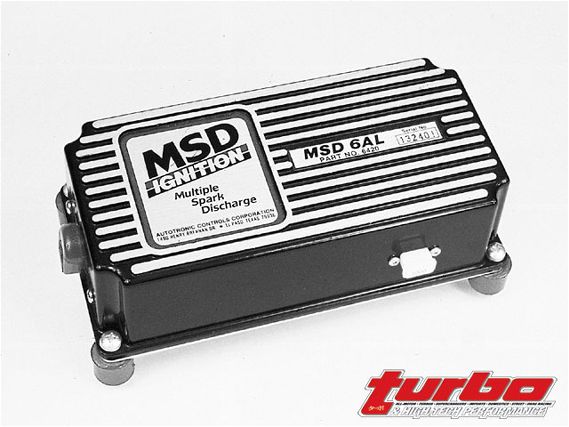 | Aftermarket Ignition Boxes
| Aftermarket Ignition Boxes
In Part 1 of Ignition Tech we covered the basics of spark plug wires along with the differences in make and design of plug wires from several wire manufacturers. We uncovered the difference in carbon conductor, solid-core conductor, spiral-core conductor and capacitor discharge wires. Part 2 will cover some of the aftermarket ignition boxes that are available and the high-tech features they offer the thrust-craving enthusiast.
First we will review the basic components of an OEM ignition system. One of the key components in any ignition system is the pick-up module. The module is usually incorporated into the distributor, mounted on the end of a camshaft or on the crank. The pick-up module is a prime-time player in the ignition system because it is responsible for sending a signal to the coil or ECU (depending on the type of ignition set-up) to ignite the compressed air/fuel mixture in the combustion chamber.
Depending on what type of ignition set-up the vehicle utilizes, the ignition will incorporate one of four types of pick-ups; points, hall-effect, magnetic and optic window. Determining the style of pick-up an engine uses will determine the model of aftermarket ignition box that is compatible with the engine. This is very important considering an ignition box that works for one engine might not necessarily work for another. Due to advances in ignition system technology, some of the older ignition pick-ups have been phased out (e.g. points, hall effect). The two most commonly used today on modern high-tech engines are magnetic pick-up and optic window-based ignition set-ups. In fact, these two styles of pick-up constitute 95 percent of all OEM ignition systems.
The second basic component in an ignition system is the coil. The important aspects of the coil are primary voltage input (voltage going into the coil) and secondary voltage output (voltage coming out of the coil). Most stock ignition systems feature a 12-volt primary input. The coil takes the 12-volt primary input and amplifies the voltage through induction within the secondary windings inside the coil and produces a higher voltage output that is far greater than the primary voltage. The secondary output voltage is directly related to the secondary windings of the coil. Every coil has different "turn ratios" (number of windings) on the primary and secondary windings which directly affect the secondary output voltage that is zapped through the wires and to the plugs.
With each car manufacturer having its own style of ignition configuration, enthusiasts and tuners are exposed to vehicles utilizing one, two, three, four, etc. coils on the engine. There are vehicles that share one coil for all the cylinders (e.g. Hondas, Acuras) and there are vehicles that incorporate coil packs (e.g. Eclipses, Grand Nationals, Mustangs) and others that utilize one coil for every cylinder (e.g. Supras and 300ZXs). This is no "seen one box, seen them all" proposition.
When do I upgrade?Ask any experienced tuner and he will tell you ignition systems do not make power. An engine makes power from compressing air and fuel in the combustion chamber and igniting it. The sole purpose of an ignition system is to ignite the compressed air/fuel at the specific time in the engine stroke. Running a super-hot ignition set-up on your vehicle does not necessarily mean your vehicle is going to make more power. The spark plugs only need enough energy to jump the gap between the electrode and the tip of the spark plug. Once there is enough energy to jump the gap the rest of the energy is wasted. However one must understand that when cylinder pressure increases (via supercharging, turbocharging, nitrous oxide or high compression) it becomes harder to jump that gap and ignite the entire air/fuel mixture. This is when an aftermarket ignition system comes into play. Performance ignition systems supply the necessary energy to help jump the gap and prevent misfires. Simply put, a performance ignition system helps prevent the loss of horsepower and allows the engine to run more efficiently. Most factory ignition systems are capable of handling the simple bolt-on upgrades such as an air filter, exhaust and header system. However once you go beyond that, an aftermarket ignition system should be considered.
There are certain advantages of running an aftermarket ignition system. One key advantage is when a race engine lacks the use of an alternator. On stock ignition systems as the battery voltage drops, so does the primary output voltage going into the coil-which in turn may cause misfires as engine speed increases and the coil does not have enough primary voltage to provide a high secondary output voltage. Some aftermarket ignition boxes are capable of providing full voltage output even when voltage drops below the normal operating range.
Some of the other features that some ignition boxes carry are two-step rev limiters and timing retard. These features are especially useful on the drag strip for launches. In addition, the retard feature can be effectively used when a nitrous system is incorporated into the equation.
Every enthusiast wants to know which performance ignition system works the best. With so many manufacturers of ignition products, the choice becomes even harder. Most ignition systems operate in the same way and the only way to determine which one will work best for your vehicle is by determining if the model in question has the features deemed necessary for your combination. The collection of popular ignition boxes we have compiled is designed to provide a basic overview of the features and capabilities of today's high-tech boxes.
